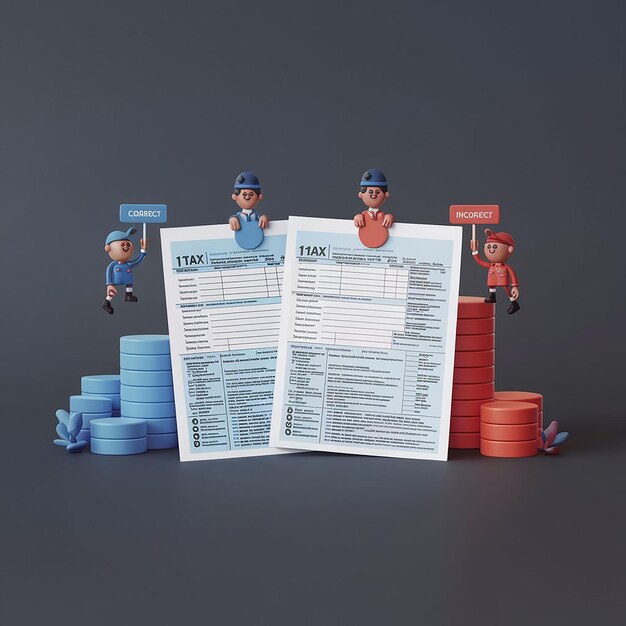New 2025 Income Tax Brackets: A Game Changer for Filers
The Internal Revenue Service (IRS) recently announced the new
Impact on Low- and Middle-Income Earners
The good news for lower- and middle-income earners is that the standard deduction will increase by $1,600 for married taxpayers filing jointly and $800 for other filers. Additionally, the
Earned Income Tax Credit (EITC)
and
Child Tax Credit
amounts will also rise slightly. However, these changes may not fully offset the impact of rising living costs for some filers in this category.
Impact on High-Income Earners
On the other hand, high-income earners may see their tax burden decrease due to the expansion of the top tax bracket. The highest income tax rate, which applies to singles earning over $539,901 and married filers earning more than $647,850, will now be 37% instead of the previous 39.6%. This change could result in considerable savings for those in this income bracket.
Impact on Small Business Owners
Small business owners could benefit from the new tax code in various ways, including changes to
business deductions and credits
, modifications to the
pass-through entity rules
, and the continued availability of the 20% Qualified Business Income (QBI) deduction. These alterations can lead to substantial tax savings for eligible small business owners and entrepreneurs.
Impact on Retirees
Retirees, too, could experience various impacts from the new tax brackets. The changes to standard deductions and potential modifications to Social Security benefits might influence their tax situation. Additionally, retirees may need to pay closer attention to required minimum distributions (RMDs) from retirement accounts, as the age for beginning these distributions has been raised to 72 from 70½.
Conclusion
The new 2025 income tax brackets bring about substantial changes for individual filers, with implications for various income levels and taxpayer groups. Taxpayers are encouraged to consult a tax professional or the IRS website for more detailed information on how these changes may impact their specific circumstances.

I. Introduction
Brief overview of the U.S. income tax system
The U.S. income tax system is a progressive tax system, meaning that different income groups are taxed at varying rates. The current tax rates range from 10% to 37%, with the highest rate applying to income above a certain threshold. This progressive nature of the tax system ensures that those who earn more pay a larger percentage of their income in taxes than those who earn less. The tax brackets are periodically adjusted to account for inflation and economic changes, which helps maintain the progressivity of the system and prevent the burdens from becoming too onerous for lower-income taxpayers.
Progressive tax system with varying rates based on income level
The U.S. income tax system is designed to be progressive, meaning that the tax rate increases as the income increases. For example, individuals earning up to $9,876 pay a 10% federal income tax rate, while those earning more than $523,601 pay a 37% tax rate.
Periodic adjustments to tax brackets due to inflation and economic changes
Tax brackets are adjusted periodically to account for inflation and economic changes. The Internal Revenue Service (IRS) typically makes these adjustments annually based on the Consumer Price Index (CPI). By making these periodic adjustments, the tax system remains responsive to changes in the economy and helps maintain the progressivity of the tax code.
Significance of the upcoming 2025 income tax bracket updates
The upcoming 2025 income tax bracket updates are significant as they will have an impact on different income groups and potentially implications for tax planning strategies.
Anticipated impact on different income groups
The 2025 income tax bracket updates are expected to affect various income groups differently. For instance, some taxpayers may face higher taxes due to the inflation adjustments, while others may see a decrease in their taxes if their income falls into a lower bracket. Additionally, changes to deductions and credits could further impact the tax burden on different income groups.
Potential implications for tax planning strategies
The 2025 income tax bracket updates could potentially have significant implications for tax planning strategies. Taxpayers may want to consider adjusting their income-generating activities, retirement savings plans, or other financial decisions to maximize the benefits of the current tax code before any changes take effect. It is essential for individuals and businesses to stay informed about these updates and consult with their tax advisors to determine how they may be impacted.

Current Income Tax Brackets
List and Explanation of Current Income Tax Brackets (2023)
The Internal Revenue Service (IRS) determines the income tax brackets, which are ranges of income that determine the applicable tax rate. Here’s a rundown of the current income tax brackets for single filers, Married Filing Jointly (MFJ), Head of Household (HOH), and Married Filing Separately (MFS):
Single Filers and Married Filing Jointly
For single filers and those married filing jointly in the tax year 2023, the following income tax brackets and rates apply:
- 10%: $0 to $9,950
- 12%: $9,951 to $41,675
- 22%: $41,676 to $89,075
- 24%: $89,076 to $163,300
- 32%: $163,301 to $209,425
- 35%: $209,426 to $539,900
- 37%: Above $539,901
Head of Household filing status
The tax brackets and rates for Head of Household (HOH) filers in 2023 are as follows:
- 10%: $0 to $9,950
- 12%: $9,951 to $43,650
- 22%: $43,651 to $87,350
- 24%: $87,351 to $164,925
- 32%: $164,926 to $209,425
- 35%: $209,426 to $528,801
- 37%: Above $528,801
Married Filing Separately
For Married Filing Separately (MFS) taxpayers, the income tax brackets and rates for 2023 are:
- 10%: $0 to $9,950 (for each spouse)
- 12%: $9,951 to $43,650 (for each spouse)
- 22%: $43,651 to $87,350 (for each spouse)
- 24%: $87,351 to $164,925 (for each spouse)
- 32%: $164,926 to $209,425 (for each spouse)
- 35%: $209,426 to $528,801 (for each spouse)
- 37%: Above $528,801 (for each spouse)
Income Thresholds and Corresponding Tax Rates for Each Bracket
The income thresholds represent the points where one enters a new tax bracket. The rates apply to all income earned within that bracket. For example, a single filer earning $41,675 will pay 12% on the first $9,950 and 22% on the remaining $31,725.
Impact of Standard Deductions, Personal Exemptions, and Other Adjustments
Standard deductions, personal exemptions, and other adjustments impact the taxable income before applying tax brackets. These reductions lower the amount of income subject to federal taxes, ultimately reducing the actual tax liability for taxpayers.

I Proposed Changes to Income Tax Brackets in 2025
The income tax landscape has been a hot topic of discussion in the political sphere, with various proposals and legislation being put forth. One of the most significant proposed changes comes from President Biden’s Build Back Better plan. This bill, if passed, would bring about significant adjustments to the income tax brackets and rates.
Background on tax policy discussions and proposed legislation
Biden’s Build Back Better plan, also known as the American Families Plan, aims to fund various social programs and infrastructure projects through tax increases on high-income earners. One of the major proposals is the restructuring of the federal income tax system, which could result in modified income tax brackets and rates.
Intended changes to income tax brackets
Under the proposed plan, there would be seven income tax brackets instead of the current seven. The rates and thresholds for each bracket are yet to be determined, but it’s anticipated that tax rates would go up for higher-income earners.
Potential effects of these proposed changes for filers
Low-income taxpayers
Low-income taxpayers, earning less than the threshold for the highest tax bracket, should not be directly affected by these changes since their income falls below the proposed thresholds.
Middle-class taxpayers
Middle-class taxpayers, whose income falls between the lower and higher thresholds, might face an increase in their effective tax rate due to the inflation adjustments. However, they could potentially benefit from other provisions within the bill such as expanded child tax credits and increased Earned Income Tax Credit.
High-income earners
High-income earners, whose income falls into the top tax brackets, would experience a more substantial impact as their tax rates are set to rise. This could lead to a larger portion of their income being subjected to federal taxes.
Analysis of how these changes might impact tax planning strategies
Taxable income management
Taxable income management would become even more crucial for high-income earners as they could potentially benefit from tax planning strategies, such as deferring income or accelerating deductions, to reduce their taxable income below the new thresholds.
Charitable giving and deductions
Charitable giving and deductions
could see significant changes as well. The proposed legislation might limit or eliminate certain deductions, making charitable donations a more attractive option for taxpayers seeking to reduce their taxable income.
Retirement savings and withdrawals
Retirement savings and withdrawals
could also be influenced by these changes, with taxpayers potentially considering adjustments to their retirement contributions or withdrawals to optimize their overall tax situation.

IV. Anticipated Challenges and Considerations for Filers in 2025
A. Uncertainties surrounding the finalization of tax law changes
As we approach the year 2025, taxpayers face numerous challenges and considerations that could significantly impact their financial planning. One of the most significant factors is the uncertainty surrounding the finalization of tax law changes.
1. Potential delays or modifications in Congress
The Congress has the power to pass tax law changes, but the process can be lengthy and unpredictable. There is a possibility of delays or modifications to proposed tax law changes that could alter the financial landscape for individuals and businesses.
2. Impact on short-term and long-term financial planning
The uncertainty surrounding tax law changes could have a significant impact on both short-term and long-term financial planning. Taxpayers may be hesitant to make major financial decisions until the tax landscape becomes clearer.
B. Strategies for taxpayers to navigate these changes effectively
Despite the uncertainties, there are strategies that taxpayers can use to navigate these changes effectively:
1. Staying informed about proposed and finalized tax law updates
The first step is to stay informed about proposed and finalized tax law updates. Taxpayers can follow the news, subscribe to reputable tax publications, or consult with their tax professionals for the latest information.
2. Consulting with tax professionals for personalized advice
Taxpayers can also consult with their tax professionals for personalized advice. Tax professionals can help individuals and businesses understand how proposed tax law changes may impact them and provide guidance on steps they can take to mitigate any potential negative effects.
3. Adjusting savings, investment, and spending strategies as needed
Finally, taxpayers may need to adjust their savings, investment, and spending strategies as needed. For example, they may need to save more for retirement or re-evaluate their investment portfolios to minimize the impact of potential tax law changes.

Conclusion
In the heart of the tax landscape, the 2025 income tax bracket updates carry significant implications for filers. First and foremost, these changes are expected to impact various income groups differently, as some taxpayers may experience a decrease in their tax liability while others might face increased taxes. The anticipated impact on low-income filers could result in a smaller tax burden due to the expansion of the lower tax brackets. Conversely, high-income earners may face a greater tax liability as a result of the elimination or narrowing of certain upper tax brackets.
Tax Planning Strategies
Given these upcoming changes, it becomes increasingly essential for filers to remain proactive and informed about their personal financial situations and the evolving tax landscape. By keeping a close eye on these developments, taxpayers can potentially optimize their tax planning strategies. For instance, some individuals may consider accelerating income or deductible expenses in the year preceding the new tax law’s implementation to take advantage of current tax rates. Others might explore alternative investment strategies that can generate tax-advantaged returns or restructure their business operations to minimize their taxable income.
The Importance of Being Informed
In conclusion, the 2025 income tax bracket updates represent a significant shift in the tax landscape that will have far-reaching implications for filers. As tax laws continue to evolve, it is crucial for individuals to remain informed and adapt their tax planning strategies accordingly. By staying up-to-date on these changes and engaging in thoughtful tax planning, filers can minimize their tax liabilities while maximizing their financial opportunities.




